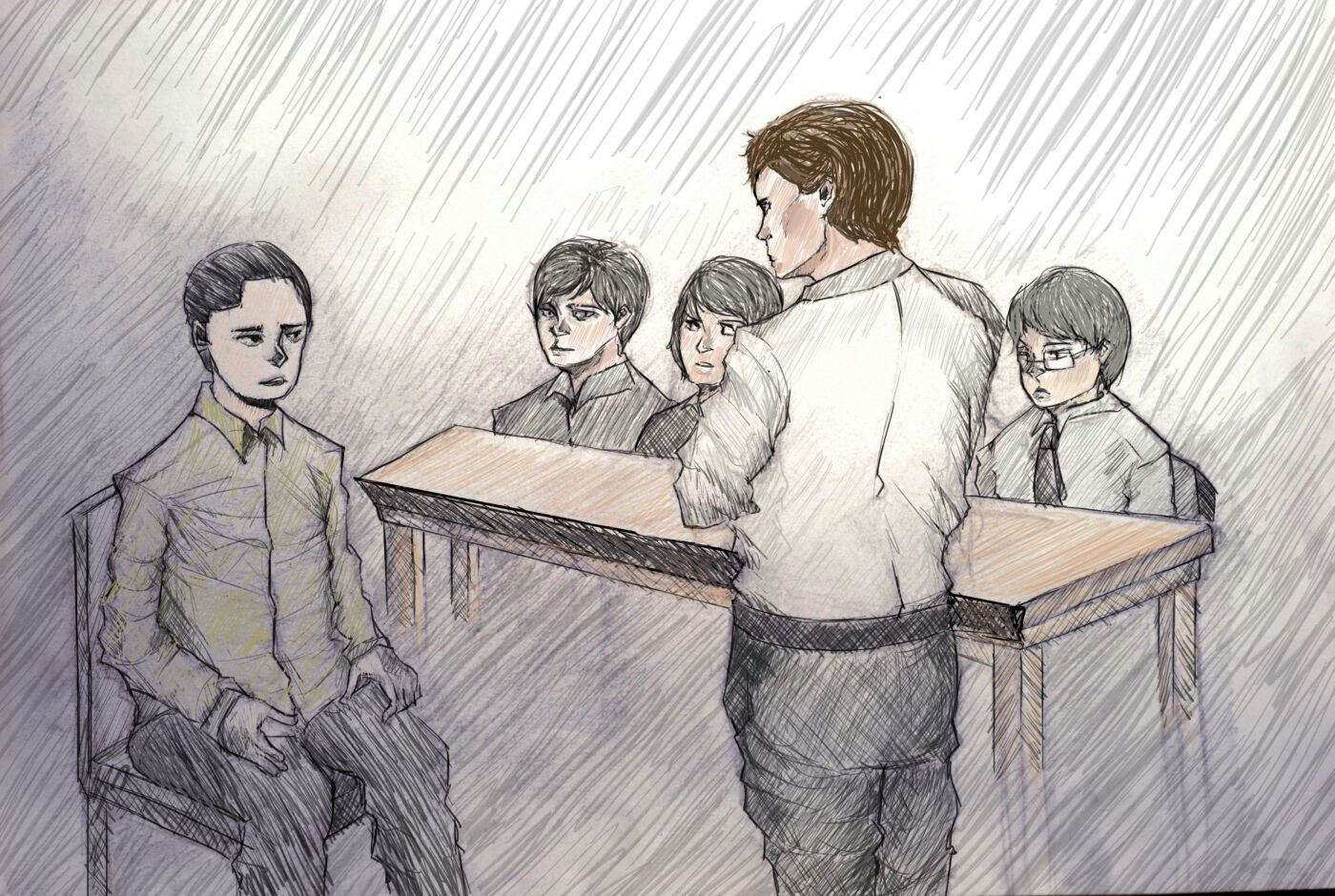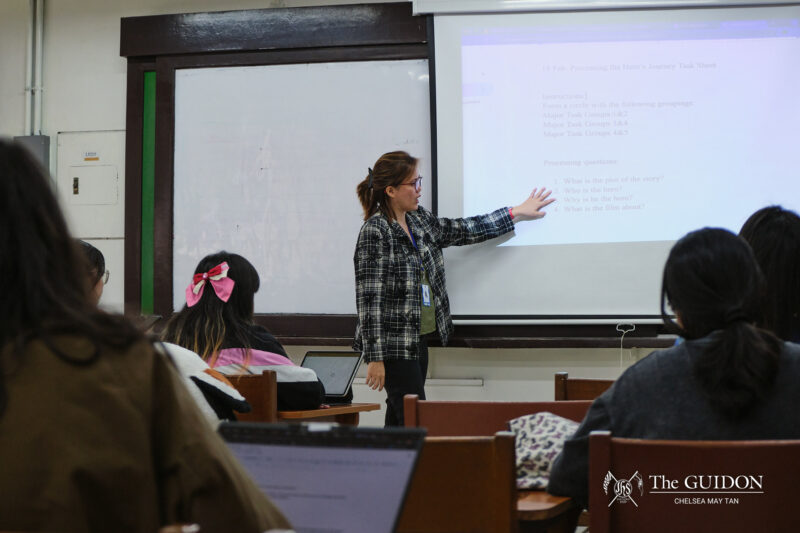ARTIST’S RENDITION. Last month, SOSS Sanggunian Sec-Treas Marvin Lagonera was tried on two impeachment counts. ILLUSTRATION BY CZARINA B. DYCAICO
A few months before filing his impeachment complaint, Chief Prosecutor Clyde Maramba began to hear rumors. The Prosecutor’s Office of the Ateneo Student Judicial Court (SJC) had received reports that “certain officials” of the School of Social Sciences (SOSS) School Board (SB) were acting in violation of the 2005 Constitution of the Undergraduate Students of the Ateneo de Manila Loyola Schools.
Believing that the rumors he heard had merit, Maramba resolved to act. On November 8, he assembled his prosecution team to plan his line of attack. Five days later, he launched a full-scale investigation on the SOSS SB, gathering documents, interviewing witnesses and collating information from a wide variety of sources. Then, one day, SOSS Secretary-Treasurer Marvin Lagonera decided he had had enough. So he made a request to meet personally with Maramba himself.
In the presence of the Magistrates of the SJC, who had elected to participate in the meeting, Lagonera openly questioned the intent of the investigation and wondered aloud whether it was even legal. Maramba’s response to these queries was equally blunt. “What Maramba said to Lagonera was, ‘We heard rumors and, therefore, we acted on it,’” Chief Magistrate Roy Guerra recounts in a mix of Filipino and English.
The recently concluded court trial that ended with the acquittal of Lagonera of the impeachment charges levied against him did more than stir up drama within the Ateneo community. In many ways, it served to shine the spotlight on the Ateneo SJC as a whole.
Yet, for such an integral component of the Sanggunian, surprisingly little is known publicly about how the SJC works. “A lot of students don’t know we exist,” Guerra says matter-of-factly.
Defining its function
According to Article XIII, Section 1 of the 2005 Sanggunian Constitution, “The Student Judicial Court is the judicial arm of the Sanggunian that hears and resolves any complaint involving the constitutionality, legality or jurisdiction of the acts, policies of Sanggunian officials.”
“Basically, we’re there to check and balance on what Sanggu does. We’re there to audit,” Guerra says. “And we’re there to check if what they do in the written minutes is what they really do in the meeting,” he adds, likely alluding to the fact that one of the charges levied against Lagonera was the falsification of minutes of various SOSS-related meetings.
In that sense, the SJC is akin to the Sanggunian’s “check and balance.” This is a term that refers to a set of rules that regulates the action of a group, ensuring that an excessive amount of power is not concentrated within a single branch. Hence, the SJC can be likened to a weighing scale, ascertaining that there is an equal distribution of weight all throughout.
Breaking down its composition
According to the SJC’s 2011 Code on Internal Procedures, the court is divided into five different departments: The Office of the Chief Magistrate, the Department of Internal Affairs Administration, the Audit Department, the Human Resources Department and the External Affairs Department. Each department is led by a magistrate and staffed with prosecutors.
The SJC’s official Facebook page says that magistrates are “tasked to uphold the provisions of all Loyola Schools legal documents pertinent to the members of its jurisdiction.” They accomplish this by overseeing the affairs of the officers of the Sanggunian, attending Sanggunian meetings, participating in SJC activities and supporting the SJC in its programs and initiatives.
In reality, however, Guerra admits that occasions wherein a magistrate has to exercise his or her judiciary powers during a trial hearing are few and far in between. This is because impeachment trials, such as the one Lagonera went through, are quite rare. Instead, magistrates usually tend to administrative duties. “Basically, what every other org does,” Guerra says.
On the other hand, a prosecutor’s job description is more specific. According to the Code of Internal Procedures, prosecutors are charged with “[facilitating] the proper check and balance on the Sanggunian and its facilitation of programs for the student body,” which is essentially the role Guerra had attributed to the entire SJC.
They act under the direct authority of the chief prosecutor, who is the equivalent of the Ombudsman in the Philippine government. Prosecutors are tasked with researching and investigating matters in response to a request for inquiry and writing reports on the issues assigned to them. In addition, they also file complaints and prosecute (or even defend) defendants during court trials, among other things.
The chief prosecutor acts under the direct supervision of the chief magistrate, who is the equivalent of the chief justice of the Supreme Court in the Philippine government. The various other prosecutors who compose the SJC, on the other hand, are employed by each of the four magistrates who marshal the other departments that comprise the judiciary. In this way, the magistrates’ and prosecutors’ roles are integrated into one another by law.
Rules of court
The SJC has a very specific set of guidelines for how to conduct trial hearings, as outlined in the 2007 SJC Rules of Court, should anyone file a complaint against an official of the Sanggunian. First, a petition is filed by the complainant to the chief magistrate, who then forwards copies to all other magistrates. The court then meets to assess the merits of the petition and then decides whether to accept the petition or not, as determined by a simple majority vote. Should the court accept the petition, a hearing will then be scheduled no later than seven days after the aforementioned decision.
The hearing itself is presided over by the chief magistrate. Each side in the hearing will have a corresponding spokesperson that will deliver oral arguments to the magistrates. In the Lagonera impeachment hearing, Maramba represented the prosecution, whereas Miko Alazas represented the defense. The latter served as the lead counsel to Lagonera. During the hearing, both sides are tasked with delivering their opening and closing statements, presenting their respective cases, rebutting the opposition’s arguments and cross-examining witnesses.
After the hearing, the magistrates then hold a closed-door meeting to deliberate, during which they determine the outcome of the case by voting whether to act in favor of the prosecution or the defense. According to the Rules of Court, “The majority opinion is the opinion agreed upon by a 2/3 majority shall become binding (sic).”
Judicial reform
Asked to assess the effectiveness of the SJC, Alazas minced no words when criticizing the court’s structural system. “One of the things that we found particularly problematic was the very fact that you have the prosecutors and the magistrates working under the same court. They hang out in the same room. I mean, a lot of them are actually very close friends,” Alazas laments. Though he stressed that he doesn’t believe there was any particular conflict of interest in the Lagonera case itself, he stated that court’s structure made it “very likely to happen.”
Maramba echoes that sentiment. “We really wanted that clear divide between the magistrates and prosecutors,” Maramba says. “People would doubt the credibility of the institution if, suddenly, we have the prosecutors who work with the magistrates be the one to file a complaint against the magistrates.”
Even Guerra admits that the system is flawed. “I know that there’s something wrong with the system. We’re the leaders of the court but at the same time we’re the judges. And therefore, judicial independence is really vague in the public eye,” he acknowledges.
Consequently, Alazas, Guerra and Maramba all spoke openly about the need for judicial reform. “That was my initial goal when I applied for chief magistrate,” Guerra says. “So what I’m planning to do for the rest of the year is to push through with the restructuring of the court in such a way that there’ll be a clear [delineation] of our duties. So that when the public sees it, they’ll know that the magistrates are for this, the prosecutors are for that and then there’s the clerk of court, who stands as medium.”
Likewise, Maramba spoke at length about the need for change in the way the SJC’s system is set up, deploring that the current structure limits his powers. “The structure prevents the prosecutors from becoming more active in this whole institution—to the point that we’re just limited to assisting the magistrates.”
In response, Maramba had pushed for a whole “restructuring” of how the court is set up. Among the things he has done is set up a new arm for the Prosecutor’s Office, which he dubbed the “Research & Development Team.” He has tasked this group with building an entirely new structure for the court from the ground up.
A long way to go
A certain irony implicit in the nature of a Sanggunian body that “checks and balances” the practices of the student government is that there are no external bodies around to check and balance the SJC itself. This is particularly problematic, given that the judicial court is not free from its fair share of problems.
“The student judicial system in the Ateneo has a really long way to go,” Alazas says straightforwardly. “A lot of the things became arbitrary so the systems, I think, in place, are the problem,” he adds, referring to the fact that the SJC had to adapt the Rules of Court of De La Salle University during the Lagonera trial.
“Technically, we adapted that because our Rules of Court aren’t as good,” Guerra concedes. “It’s somewhat vague on some parts. That’s why he had to suspend a lot of things.”
Nevertheless, Guerra disagrees with Alazas’ negative assessment of the court. “Based on the hearing alone, I believe we’re effective,” he says, attributing the perception of the ineffectiveness of the SJC to the political apathy of the student body. “The decision we made can speak for itself.”







